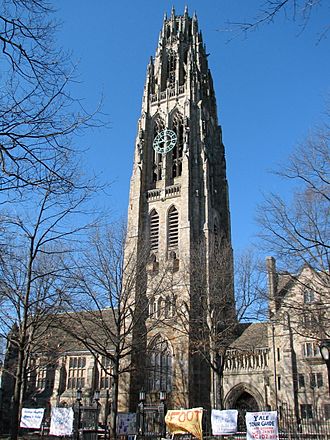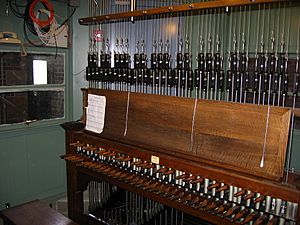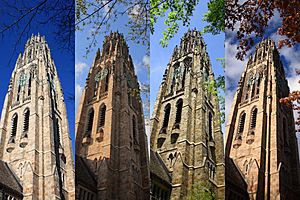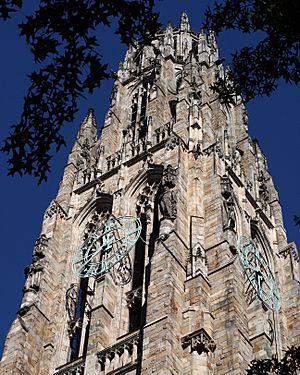Harkness Tower facts for kids
Quick facts for kids Harkness Tower |
|
|---|---|
 |
|
| General information | |
| Architectural style | Collegiate Gothic |
| Location | New Haven, Connecticut |
| Construction started | 1917 |
| Completed | 1921 |
| Owner | Yale University |
| Height | 216 ft. (66 m) |
| Technical details | |
| Floor count | 9 |
| Design and construction | |
| Architect | James Gamble Rogers |
| Other designers | Lee Lawrie, sculptor |
Harkness Tower is a tall, impressive stone tower at Yale University in New Haven, Connecticut. It's part of a beautiful group of buildings called the Collegiate Gothic Memorial Quadrangle. This complex was finished in 1922. The tower is named after Charles William Harkness. He was the brother of Edward Harkness, who gave a lot of money to Yale.
Contents
History of Harkness Tower
The tower was built between 1917 and 1921. It was part of the Memorial Quadrangle project. Anna M. Harkness donated the money for it. She wanted to honor her son, Charles William Harkness. He had graduated from Yale in 1883.
Later, in 1933, Yale started its residential college system. The tower then became part of Branford College.
James Gamble Rogers designed the tower. He was a classmate of Anna Harkness's other son, Edward S. Harkness, at Yale College. James S. Hedden was the supervisor for the construction. He took many photos as the tower was being built.
The tower was repaired from September 2009 to May 2010. Workers fixed its stone parts and decorations.
How Harkness Tower Influenced Others
Harkness Tower was the first "crown" tower built in the modern age. It used the English Perpendicular Gothic style. James Gamble Rogers, the architect, said it was inspired by the "Boston Stump." This is a 272-foot (83 m) tower of a church in Boston, Lincolnshire, England. It is the tallest church tower in England.
Rogers also based some details on a 16th-century church tower in Wrexham, Wales. This is where Elihu Yale is buried. In turn, Harkness Tower inspired the tower of the Cathedral of Christ the King in Hamilton, Ontario, Canada.
The image of Harkness Tower is also used by the Yale Herald. This is a weekly student newspaper at Yale. Its picture is on the newspaper's masthead.
Design of the Tower
Harkness Tower stands 216 feet (66 m) tall. This is one foot for each year since Yale was founded when the tower was built. It starts with a square base. Then it rises in different sections. At the top, it has a double stone crown on an eight-sided base. Stone decorations called finials are at the very top. There are 284 steps from the street to the roof.
Halfway up the tower, there are four open copper clock faces. They show the time. The bells of the carillon are behind these clock faces. They are attached to a strong steel frame. The special keyboard used to play the carillon is just below the clock faces.
Lower parts of the tower used to hold a water tank. Now, they have two practice carillons. There is also an old chimes playing area. The office for the Yale University Guild of Carillonneurs is here too. A small memorial chapel is also inside.
Building Materials
The tower was built using separate stone blocks. In 1966, steel was added to make it stronger. This was done to support the new, heavier bells in the carillon.
Yale tour guides often tell a story about the tower. They say it was once the world's tallest free-standing stone building. The story claims it needed steel because someone poured acid on it to make it look old. However, this is just a legend. The Washington Monument was much taller and built long before Harkness Tower.
Tower Decorations
Lee Lawrie sculpted the decorations on the tower. The lowest sculptures show Yale's "Eight Worthies." These are important people from Yale's history. They include Elihu Yale, Jonathan Edwards, Nathan Hale, and Noah Webster. Others are James Fenimore Cooper, John C. Calhoun, Samuel F. B. Morse, and Eli Whitney.
The next level of sculptures shows famous thinkers. These include Phidias, Homer, Aristotle, and Euclid. The level above that has figures that represent ideas. These include Medicine, Business, Law, and the Church. Other figures show Courage, Effort, War, Peace, Generosity, Order, Justice, Truth, Life, Progress, Death, and Freedom.
The gargoyles at the very top show Yale students. They are seen at war and studying. One is a writer, another is an athlete. There's also a socialite drinking tea and a diligent scholar. Masks of Homer, Virgil, Dante, and Shakespeare are also there.
The Yale Memorial Carillon

The tower holds the Yale Memorial Carillon. This is a musical instrument with 54 bells. It is a transposing instrument, meaning the C bell sounds like a concert B. Ten bells were put in the tower in 1922. Another 44 bells were added in 1966.
Students who are part of the Yale Guild of Carillonneurs play the instrument. Sometimes, guest carillonneurs also play. During the school year, the carillon is played twice a day. There is a half-hour session at 12:30 p.m. and a one-hour session at 5:30 p.m. Some students living nearby jokingly call the daily performances "Heavy Metal." In the summer, it is played only in the evening. There is also a series of Friday concerts in the summer. Playing of the carillon stopped in 2009 and 2010 during the tower's renovation.
See also
 In Spanish: Harkness Tower para niños
In Spanish: Harkness Tower para niños



